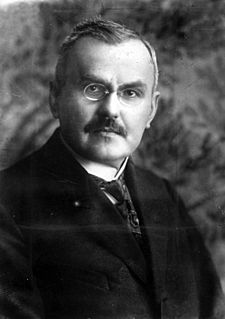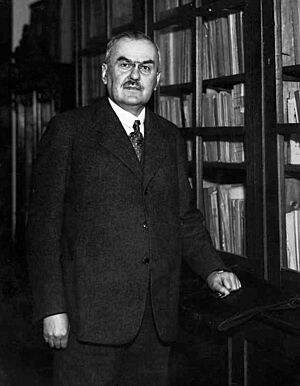Władysław Grabski facts for kids
Quick facts for kids
Władysław Grabski
|
|
|---|---|

Władysław Grabski
|
|
| 5th & 12th Prime Minister of Poland | |
| In office 19 December 1923 – 14 November 1925 |
|
| President | Stanisław Wojciechowski |
| Deputy | Stanisław Thugutt |
| Preceded by | Wincenty Witos |
| Succeeded by | Aleksander Skrzyński |
| In office 27 June 1920 – 24 July 1920 |
|
| President | Józef Piłsudski (Chief of State) |
| Preceded by | Leopold Skulski |
| Succeeded by | Wincenty Witos |
| Minister of Finance of Poland | |
| In office 19 December 1923 – 14 November 1925 |
|
| Prime Minister | Himself |
| Preceded by | Władysław Kucharski |
| Succeeded by | Jerzy Zdziechowski |
| In office 13 January 1923 – 1 July 1923 |
|
| Prime Minister | Władysław Sikorski Wincenty Witos |
| Preceded by | Bolesław Markowski |
| Succeeded by | Hubert Linde |
| In office 13 December 1919 – 25 November 1920 |
|
| Prime Minister | Leopold Skulski Himself Wincenty Witos |
| Preceded by | Leon Biliński |
| Succeeded by | Jan Kanty Steczkowski |
| Personal details | |
| Born |
Władysław Dominik Grabski
7 July 1874 Borów, Congress Poland, Russian Empire |
| Died | 1 March 1938 (aged 63) Warsaw, Second Polish Republic |
| Resting place | Powązki Cemetery, Warsaw |
| Political party | National-Democratic Party Popular National Union |
| Spouse | Katarzyna Lewandowska (since 1902) |
| Children | 4, including Władysław Jan |
| Relatives | Małgorzata Kidawa-Błońska (great-granddaughter) |
| Occupation | Politician, economist |
| Signature | |
Władysław Dominik Grabski (born July 7, 1874 – died March 1, 1938) was an important Polish politician, economist, and historian. He is best known for fixing Poland's money system after World War I. He served as the Prime Minister of Poland twice, first in 1920 and then from 1923 to 1925. He was also the brother of Stanisław Grabski and Zofia Kirkor-Kiedroniowa.
Grabski was key in creating the Bank of Poland and introducing the zloty currency. His government was the longest-lasting in Poland between the two World Wars. However, some people criticized his work. For example, Stanisław Głąbiński thought Grabski wasn't strong enough in international talks. Wincenty Witos felt his farming reforms were not good enough.
Contents
Who was Władysław Grabski?
Władysław Grabski was born in 1874 in Borów, a village near Łowicz, which was then part of the Russian Empire. He studied politics in Paris at the École Libre des Sciences Politiques and history at the University of Sorbonne. While in Paris, his political ideas changed. He moved away from socialist views and became more conservative.
Early Political Life and Activism
After returning from Paris, Grabski became very involved in Polish public life. In 1905, he started the Agricultural Society in Łowicz. This group quickly gained support from many farmers. This led to the creation of the National Labor Union.
The growing strength of Grabski's groups worried the Russian authorities. In 1905, he was arrested and put in prison in Warsaw. Luckily, he was released in less than a year. Later in 1905, he was elected to the Duma, which was the Russian Empire's law-making body. He served there until 1912. During this time, he worked on the budget for the Russian Ministry of Agriculture. This experience made him want to become Poland's finance minister later on.
When World War I started, Grabski helped organize the Central Citizens' Committee. This committee worked to bring order back to Polish society. It also represented Polish interests to the Russian government. He also joined the Polish National Committee. In 1919, he became the Minister of Agriculture in the newly independent Poland.
Grabski as Prime Minister
Grabski's influence grew when he became both Treasury Minister and Prime Minister in 1920. However, his first time as Prime Minister lasted only one month. In December 1923, he was again chosen as Prime Minister and also served as Treasury Minister. This time, he led a special government made of experts.
Grabski successfully introduced changes that helped Poland's economy. His government stayed in power for twenty-three months. This was a long time for a Polish government between the wars. Until the end of 1924, many people liked Grabski's government.
Challenges and Criticisms
Even though he was successful, Grabski faced criticism during his time in office. Stanisław Głąbiński, for example, felt that Grabski was not firm enough in foreign relations. At a meeting of the League of Nations, Grabski did not bring up the League's lack of help during the Polish-Soviet War (1919–1921). The League was supposed to protect its members from outside attacks, but it did not act in 1920. This decision led to strong criticism from the Polish parliament.
Wincenty Witos also criticized Grabski. He thought Grabski was too hopeful about his money reforms. However, these reforms did stop the very fast price increases, known as hyperinflation.
On November 13, 1925, Grabski had to resign. This happened after he disagreed with the head of the Bank of Poland. The bank refused to help him with support from a group of industrialists.
What was the Currency Reform?
One of Grabski's biggest achievements was setting up the Bank of Poland. He also created a new Polish currency, the zloty, which was based on gold. This new currency replaced the old Polish mark.
How the New Currency System Worked
A law passed on January 11, 1924, helped improve Poland's money situation. It created a new money system and set up the bank that would issue the currency. The Bank of Poland was created as a joint stock company. This meant it was independent from the government and the state's money. The law also closed the Polish National Savings Union, which used to issue money. The Bank of Poland took over its duties. Stanisław Karpiński became the first president of the Bank of Poland.
On January 14, a committee was formed to organize the Bank of Poland. On January 26, people could start buying shares in the bank. They could only pay with foreign money or gold. On April 15, the Bank of Poland Joint Stock Company was officially created at its first meeting.
Grabski did more than just create the Bank of Poland and the zloty. He also built a network of state banks and started the Bank for National Economy. He made important changes to how Poland exported goods and produced industrial products. He also set up the Border Defence Corps to protect the country's borders.
Challenges After the Reforms
Even with these successes, Grabski's reforms still faced criticism. In 1925, Grabski himself admitted he had been too optimistic. He realized that a full recovery for Poland's economy was very hard. This was because the country was still recovering from World War I and facing a depression.
There were big differences in prices between farm goods and manufactured goods. The Bank of Poland faced problems with trade and a growing national debt. The government made many bad investments. In 1925, the parliament approved a budget that was too high, even though Grabski's government warned against it. On July 29, 1925, the value of the Polish złoty dropped a lot. A trade war also started between Poland and Germany.
Grabski left active politics in November 1925. He then focused on teaching and academic work at the Warsaw Agricultural University (SGGW). In 1926, he became its head, known as the rector. In 1936, he helped create the Rural Sociology Institute and led it until he died in 1938.
Władysław Grabski passed away from cancer on March 1, 1938, in Warsaw. His funeral was held at the Saint John's Cathedral. He was buried in his family's grave at the Powązki Cemetery.
Grabski's Legacy and Impact
In 2004, Poland celebrated important anniversaries related to Władysław Grabski. These included the 130th anniversary of his birth and the 80th anniversary of his financial reforms. In September 2003, the Polish parliament declared 2004 as Władysław Grabski's Year.
In 2004, a statue of Grabski was put up in his hometown of Borów. The Warsaw Agricultural University called him a "great Pole, great statesman, social activist and a man of great heart and mind, one of the brightest Poles of the interwar period." In July 2006, the main library of the Warsaw Agricultural University was named after Grabski. A statue of him was also placed in front of the library.
His grandson, Andrzej Feliks Grabski (1934–2000), became a historian.
Works by Władysław Grabski
- Historia Towarzystwa Rolniczego 1858–1861 (1904)
- Bilans Królestwa Polskiego w finansach Rosji (1909)
- Rocznik Statystyczny Królestwa Polskiego 1914 (ed.) (1915)
- Cel i zadania polityki agrarnej w Polsce (1918)
- O własnych siłach (1926)
- Dwa lata pracy u podstaw państwowości naszej (1927)
- Historia wsi w Polsce (1929)
- Kryzys rolniczy (1929)
Awards and Honors
- Knight of the Order of the White Eagle (April 12, 1924)
- Knight Grand Cross of the Order of the Crown (Romania)
- Order of Orange-Nassau (Netherlands)
- Knight of the Order of Saints Maurice and Lazarus (Italy)
- Order of the White Lion, 1st class (Czechoslovakia)
- Grand Cross of the Order of Pius IX (Vatican City)
- Order of the Cross of Liberty, 1st class (Civil) (Estonia)
Images for kids
See also
 In Spanish: Władysław Grabski para niños
In Spanish: Władysław Grabski para niños




